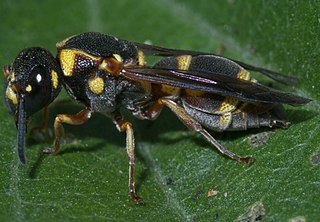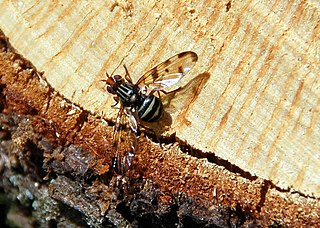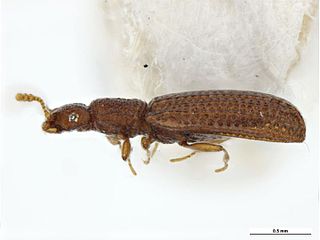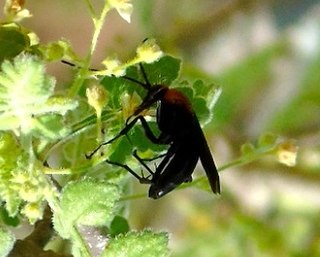
The Ulidiidae or picture-winged flies are a large and diverse cosmopolitan family of flies (Diptera), and as in related families, most species are herbivorous or detritivorous. They are often known as picture-winged flies, along with members of other families in the superfamily Tephritoidea that have patterns of bands or spots on the wings. Some species share with the Tephritidae an unusual elongated posteroapical projection of the anal cell in the wing, but can be differentiated by the smoothly curving subcostal vein. Two species, Tetanops myopaeformis and Euxesta stigmatias, are agricultural pests.

Monobia is a primarily neotropical genus of medium-sized to large potter wasps occurring from the United States to Argentina. This genus is very closely related to the genus Montezumia. It contains the following species:

Odynerus is a primarily Holarctic genus of potter wasps.
Hypodynerus is a South American, primarily Andean, genus of potter wasps with most of its described species inhabiting Chile. The species included in Hypodynerus include:
Discoelius is a palearctic genus of potter wasps with seven currently known species. It contains the following species:

Stenodynerus is a rather large genus of potter wasps whose distribution spans the Nearctic, Palearctic, Oriental and Neotropical regions. Most of its species lack a transverse carina on the first metasomal tergum. A pair of medial pits on the anterior face of the pronotum and the expansion of the tegulae put this genus close to genera as Parancistrocerus, Hypancistrocerus and Eustenancistrocerus.

Pseudodynerus is a small Neotropical genus of potter wasps currently containing 16 species.

Otitinae is the name of a subfamily of flies in the family Ulidiidae. It was formerly the Otitidae. Like the Ulidiinae, most species are herbivorous or saprophagous. Most species share with the Tephritidae an unusual elongated projection of the anal cell in the wing, but can be differentiated by the smoothly curving subcostal vein. Most are dull gray to shiny brown or black flies with vein R1 setulose or, in a few cases, bare.

Dienerella is a genus of beetles in the family Latridiidae, containing the following species:

Aphalaridae is a bug family in the superfamily Psylloidea.
Rhinocolinae is a subfamily of jumping plant louse in the family Aphalaridae.

Diaphorinae is a subfamily of flies in the family Dolichopodidae.

Juan (Jean) Brèthes, also known as Frère Judulien Marie or Juan Brethes was an Argentine scientist, naturalist, entomologist, ornithologist, zoologist and geologist. He was the first entomologist of the National Museum, today known as the Argentine Museum of Natural Sciences. He was a close collaborator of Florentino Ameghino, and translated several of his works into French. Thanks to his intense activity, he systematized a large number of Latin American insect species. He was a precursor in the fight against agricultural pests at a time when insecticides had not been developed to combat them.
Podium is a genus of thread-waisted wasps in the family Sphecidae. There are at least 20 described species in Podium.
Pseneo is a genus of aphid wasps in the family Crabronidae. There are more than 20 described species in Pseneo.

Evania is a genus of ensign wasps in the family Evaniidae. Like all members of the family, they are cockroach egg parasitoids. There are more than 60 described species in Evania. Evania appendigaster, the blue-eyed ensign wasp, is a common wasp found through most of the world.

Notocyphus is a genus of spider wasps, belonging to the family Pompilidae. They are the only genus in the monotypic subfamily Notocyphinae. These wasps are found in the Nearctic and the Neotropics.
Omicron acapulsece is a species of neotropical wasps that belongs to the genus Omicron and is found in South and Central America. It was discovered by Cameron in the year 1912. The species is diurnal. There is one subsepecies, Omicron acapulcense tenulum.











